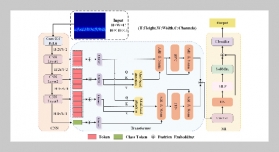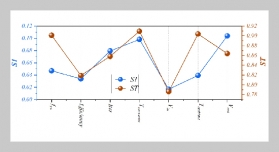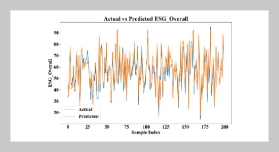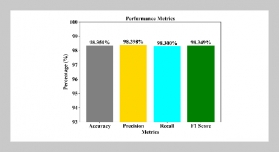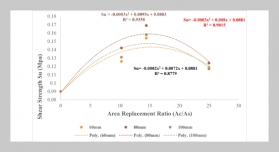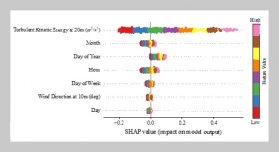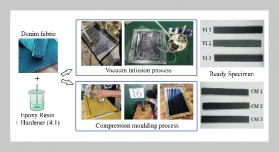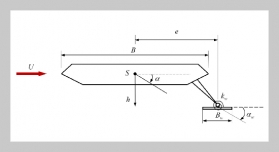- [1] G.Casella and R. L. Berger. Statistical Inference. 2nd. California: The Wadsworth Group, 2001. Chap. 7.
- [2] C.C.HolmsandS.G.Walker, (2003) “Statistical Inference with Exchangeability and Martingales" Philosophical Transactions of the Royal Society A 381: 1–17. DOI: 10.1098/rsta.2022.0143.
- [3] J. Siebert, (2023) “Applications of Statistical Causal Inference in Software Engineering" Information and Software Technology 159: 1–34. DOI: 10.1016/j.infsof.2023.107198.
- [4] T. T. Cal, Z. Gua, and R. Ma, (2023) “Statistical Inference for High-Dimensional Generalized Linear Models with Binary Outcomes" Journal of the American Sta tistical Association 118: 1319–1332. DOI: 10.1080/01621459.2021.1990769.
- [5] C.H.Chong, M.Hoffmann, Y. Liu, M. Rosenbaum, and G. Szymanski, (2024) “Statistical Inference for Rough Volatility: Central Limit Theorems" The Annals of Applied Probability 34: 2600–2649. DOI: 10.1214/ 23-AAP2002.
- [6] J. L. Wadsworth and R. Campbell, (2024) “Statistical Inference for Multivariate Extremes via a Geometric Approach" Journal of the Royal Statistical Society Series B: Statistical Methodology 86: 1243–1265. DOI: 10.1093/jrsssb/qkae030.
- [7] P. C. Bellec and C.-H. Zhang, (2023) “Debiasing Con vex Regularized Estimators and Interval Estimation in Linear Models" The Annals of Statistics 51: 391–436. DOI: 10.1214/22-AOS2243.
- [8] C.Shi, J. Zhu, Y. Shen, S. Luo, H. Zhu, and R. Song, (2024) “Off-Policy Confidence Interval Estimation with Confounded Markov Decision Process" Journal of the American Statistical Association 119: 273–284. DOI: 10.1080/01621459.2022.2110878.
- [9] S. F. Cheung, I. J. Agaloos Pesigan, and W. N. Vong, (2023) “DIY Bootstrapping: Getting the Nonparametric Bootstrap Confidence Interval in SPSS for any Statistics or Function of Statistics" Behavior Research Methods 55: 474–490. DOI: 10.3758/s13428-022-01808-5.
- [10] L.MakkonenandM.Tikanmaki,(2019)“AnImproved Method of Extreme Value Analysis" Journal of Hydrology 2: 1–7. DOI: 10.1016/j.hydroa.2018.100012.
- [11] H.Tabari, (2021) “Extreme Value Analysis Dilemma for Climate Change Impact Assessment on Global Flood and Extreme Precipitation" Journal of Hydrology 593: 1 56. DOI: 10.1016/j.jhydrol.2020.125932.
- [12] R.Raiman, S.Sukono, S.Supian, and N.Ismail,(2021) “Analysing the Decision Making for Agricultural Risk Assessment: An Application of Extreme Value Theory" Decision Science Letters 10: 351–360. DOI: 10.5267/j.dsl.2021.2.003.
- [13] F. D. Paola, M. Giugni, F. Pugliese, A. Annis, and F. Nardi, (2018) “GEV Parameter Estimation and Stationary vs. Non-Stationary Analysis of Extreme Rain fall in African Test Cities" Hydrology 5: 1–23. DOI: 10.3390/hydrology5020028.
- [14] S. Yoon, W. Cho, J.-H. Heo, and C. E. Kim, (2010) “A Full Bayesian Approach to Generalized Maximum Likelihood Estimation of Generalized Extreme Value Distribution" Stochastic Environmental Research and Risk Assessment 24: 761–770. DOI: 10.1007/s00477-009 0362-7.
- [15] A. Shabri, U. N. Ahmad, and Z. A. Zakaria, (2011) “TL-Moments and L-Moments Estimation of the Generalized Logistic Distribution" Journal of Mathematics Research 3: 97–106. DOI: 10.5539/jmr.v3n1p97.
- [16] S. B. Habeeb, F. K. Abdullah, R. N. Shalan, A. S. Hassan, E. M. Almetwally, F. M. Alghamdi, S. M. Ahmed Alsheikh, and M.Hossain,(2024)“Comparisonof Some Bayesian Estimation Methods for Type-I Generalized Ex treme Value Distribution with Simulation" Alexandria Engineering Journal 98: 356–363. DOI: 10.1016/j.aej.2024.04.042.
- [17] Y. Ali, S. Washington, and M. Haque, (2023) “Estimating Real-Time Crash Risk at Signalized Intersections: A Bayesian Generalized Extreme Value Approach" Safety Science 164: 1–9. DOI: 10.1016/j.ssci.2023.106181.
- [18] A.Louzaoui and M.E.Arrouchi,(2020) “On the Maximum Likelihood Estimation of Extreme Value Index Based on k-Record Values" Journal of Probability and Statis tics 2020: 1–9. DOI: 10.1155/2020/5497413.
- [19] S. E. Adlouni, T. B. Ouarda, X. Zhang, R. Roy, and B. Bobée, (2007) “Generalized Maximum Likelihood Estimators for the Nonstationary Generalized Extreme Value Model" Water Resources Research 43(3): 1–14. DOI: 10.1029/2005WR004545.
- [20] F. Krüger, S. Lerch, T. Thorarinsdottir, and T. Gneiting, (2021) “Predictive Inference based on Markov Chain MonteCarloOutput "International Statistical Review 89: 274–301. DOI: 10.1111/insr.12405.
- [21] S. A. Khan, I. Hussain, T. Hussain, F. Muhammad, Y. S. Muhammad, and A. M. Shoukry, (2017) “Re gional Frequency Analysis of Extremes Precipitation us ing L-Moments and Partial L- moments" Advances in Meteorology 2017: 1–20. DOI: 10.1155/2017/6954902.
- [22] E. Tanprayoon, U. Tonggumnead, and S. Aryuyuen, (2023) “New Extension of Generalized Extreme Value Distribution: Extreme Value Analysis and Return Level Estimation of the Rainfall Data" Trends in Sciences 20: 1–13. DOI: 10.48048/tis.2023.4034.
- [23] E. S. Martins and J. R. Stedinger, (2000) “Generalized Maximum-Likelihood Generalized Extreme-Value Quan tile Estimators for Hydrologic Data" Water Resources Research 36: 737–744. DOI: 10.1029/1999WR900330.
- [24] J. L. Ng, K. H. Chan, N. I. F. Noh, R. Razman, S. Surol, J. C. Lee, and R. A. Al-Mansob, (2022) “Statistical Modelling of Extreme Temperature in Peninsular Malaysia" IOP Conference Series: Earth and Environmental Science 1022: 1–9. DOI: 10.1088/1755-1315/1022/1/012072.
- [25] S. Coles. An Introduction to Statistical Modeling of Ex treme Values. London: Springer, 2001. Chap. 1.
- [26] J. Beirlant, Y. Goegebeur, J. Teugels, and J. Segers. Statistics of Extremes: Theory and Applications. New York: John Wiley & Sons, 2004. Chap. 1.
- [27] J. Nocedal and S. J. Wright. Numerical Optimization. 2nd. New York: Springer, 1999. Chap. 1.
- [28] E. Greenshtein and Y. Ritov, (2022) “Generalized Maxi mumLikelihood Estimation of the Mean of Parameters of Mixtures, with Applications to Sampling and to Observational Studies" Electronic Journal of Statistics 16: 5934–5954. DOI: 10.1214/22-EJS2082.
- [29] S. Brooks, (2002) “Markov Chain Monte Carlo Method and its Application" Journal of the Royal Statistical Society: Series D (the Statistician) 47: 69–100. DOI: 10.1111/1467-9884.00117.
- [30] S. Chib and E. Greenberg, (1995) “Understanding the Metropolis-Hastings Algorithm" The American Statis tician 49(4): 327–335. DOI: 10.1080/00031305.1995.10476177.
- [31] A. Gelman, J. B. Carlin, H. S. Stern, D. B. Dunson, A. Vehtari, and D. B. Rubin. Bayesian Data Analysis. 3rd. Florida: CRC Press Taylor & Francis Group, 2013. Chap. 2.
- [32] A.Gelman and D.B.Rubin,(1992)“Inferencefrom Iter ative Simulation Using Multiple Sequences" Statistical Science 7: 457–472. DOI: 10.1214/ss/1177011136.
- [33] J.R.M.Hosking,(1990) “L-moments: Analysis and Estimation Distributions using Linear Combinations of Order Statistics" Journal of the Royal Statistical Society Series B: Statistical 52: 105–124. DOI: 10.1111/j.2517-6161.1990.tb01775.x.
- [34] E. A. H. Elamir and A. H. Seheult, (2004) “Exact Vari ance Structure of Sample L-moments" Journal of Sta tistical Planning and Inference 124: 337–359. DOI: 10.1016/S0378-3758(03)00213-1.
- [35] J. Karvanen, (2006) “Estimation of Quantile Mixtures via L-Moments and Trimmed L-moments" Computa tional Statistics & Data Analysis 51: 947–959. DOI: 10.1016/j.csda.2005.09.014.
- [36] E. Gilland and R. W. Katz, (2016) “extRems 2.0: An Extreme Value Analysis Package in R" Journal of Sta tistical Software 72: 1–39. DOI: https://doi.org/10.18637/jss.v072.i08.
- [37] D. A. Dickey and W. A. Fuller, (1979) “Distribution of the Estimators for Autoregressive Time Series with a Unit Root" Journal of the American Statistical As sociation 74: 427–431. DOI: 10.1080/01621459.1979.10482531.
- [38] R. M. Hirsch, J. R. Slack, and R. A. Smith, (1982) “Techniques of Trend Analysis for Monthly Water Quality Data" Water Resources Research 18: 107–121. DOI: 10.1029/WR018i001p00107.
- [39] T. R. Ferreira, G. R. Liska, and L. A. Beijo, (2024) “As sessment of Alternative Methods for Analysing Maximum Rainfall Spatial Data based on Generalized Extreme Value Distribution" Discover Applied Science 6: 1–21. DOI: https://doi.org/10.1007/s42452-024-05685-9.
- [40] Z. Jiao, A. Alam, J. Yuan, C. Farnham, and K. Emura, (2024) “Prediction of Extreme Rainfall Events in 21st Century- The results Based on Bayesian Markov Chain Monte Carlo" Urban Climate 53: 1–13. DOI: 10.1016/j.uclim.2024.101822.
- [41] S. H. Lee and S. J. Maeng, (2005) “Estimating of Drought Rainfall using L-Moments" Irrigation and Drainage 54: 279–294. DOI: 10.1002/ird.178.
- [42] T. Prahadchai, Y. Shin, P. Busababodhin, and J.-S. Park, (2023) “Analysis of Maximum Precipitation in Thailand using Non-Stationary Extreme Value Models" Atmospheric Science Letters 24: 1–11. DOI: 10.1002/asl.1145.
- [43] R. Choudury and T. D. Roy, (2024) “Rainfall Analy sis of Guwahati City using the Method of L-Moments, Tl-Moments & Maximum Likelihood Estimation" International Journal of Scientific Research in Multidisciplinary Studies 10: 19–25. DOI: 10.26438/ijsrms/v10i5.1925.
- [44] I. Christos, P. Galiatsatou, V. Glenis, P. Prinos, and C. Kilsby, (2023) “Urban Flood Modelling under Extreme Rainfall Conditions for Building-Level Flood Exposure Analysis" Hydrology 10: 1–19. DOI: 10.3390/hydrology10080172.




